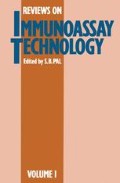Abstract
Phycobiliproteins are large proteins made by red algae and cyanobacteria as part of their photosystem II high harvesting system (Glazer, 1977; Gantt and Lipschultz (1973); Lipschultz and Gantt, 1981). R-phycoerythrin (PE) is a phycobiliprotein composed of three non-covalently associated subunits, each of which contains fluorescent bilin groups.
Access this chapter
Tax calculation will be finalised at checkout
Purchases are for personal use only
Preview
Unable to display preview. Download preview PDF.
Notes
Gantt, E. and Lipschultz, C. A. (1973). Energy transfer in phycobilisomes from phycoerythrin to allophycocanin. Biochimica et Biophysica Acta, 292, 858–861
Glazer, A. N. (1977). Structure and molecular organization of the photosynthetic accessory pigments of cyanobacteria and red algae. Molecular and Cellular Biochemistry, 18, 125–140
Grassetti, D. R. and Murray, J. F. (1960). Determination of sulfhydry 1 groups with 2,2’- or 4,4’-diothiodipyridine. Archives of Biochemistry and Biophysics, 119, 41–49
Ishikawa, E. (1983). Enzyme-labelling of antibodies. Journal of Immunoassays, 4, 208–327
Jolley, M. E. Wang, C.-H. J., Ekenberg, S. J., Zuelke, M. S. and Kelso, D. M. (1984). Particle concentration fluorescence immunoassay (PCFIA): a new rapid immunoassay technique with high sensitivity. Journal of Immunological Methods, 67, 21–35
Kronick, M. N. and Grossman, P. D. (1983). Immunoassay techniques with fluorescent phycobiliprotein conjugates. Clinical Chemistry, 29, 1582–1586
Ledbetter, J. A., Hewgill, D. H., Watson, B. A. and Gallagher, M. S. (1984). Practical aspects of two-color cytofluorimetry using a single argon laser. Lymphocyte surface antigens. Perspectives in Immunogenetics and Histocompatibility, 6, 119–129
Lipschultz, C. A. and Gantt, E. (1981). Association of phycoerythrin and phycocyanin: in vitro formation of a functional energy transferring phycobilisome complex of Porphyridium sordidum. Biochemistry, 20, 3371–3381
Oi, V. T., Glazer, A. N., and Stryer, L. (1982). Fluorescent phycobiliprotein conjugates for analyses of cells and molecules. Journal of Cell Biology, 93, 981–986
Rutner, H., Rapum, R. and Lewis, N. (1974). Derivative of digoxigenin. U.S. Patent 3,855,208
BIBLIOGRAPHY
Molecular Probes (1984). Conjugations of Phycobiliproteins to Biological Molecules, Molecular Probes Inc., 24750 Lawrence Road, Junction City OR 97448, U.S.A.
Editor information
Editors and Affiliations
Copyright information
© 1988 S. B. Pal and the Contributors
About this chapter
Cite this chapter
Monji, N., Castro, A. (1988). Conjugation of Haptens and Macromolecules to Phycobiliprotein for Application in Fluorescence Immunoassay. In: Pal, S.B. (eds) Reviews on Immunoassay Technology. Palgrave Macmillan, London. https://doi.org/10.1007/978-1-349-09854-5_4
Download citation
DOI: https://doi.org/10.1007/978-1-349-09854-5_4
Publisher Name: Palgrave Macmillan, London
Print ISBN: 978-1-349-09856-9
Online ISBN: 978-1-349-09854-5
eBook Packages: Biomedical and Life SciencesBiomedical and Life Sciences (R0)

